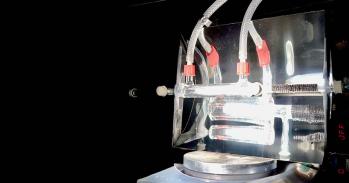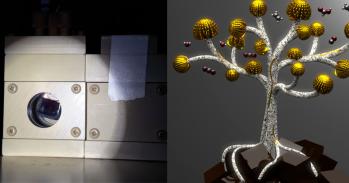
Angela Harper is a PhD candidate at the Cavendish Laboratory, a member of Churchill College, and a Gates Cambridge Scholar. Here, she tells us about her work in renewable energy, setting up a Girls in STEM programme while she was an undergraduate in North Carolina, and the importance of role models when pursuing a career in STEM.
Angela Harper is a PhD candidate at the Cavendish Laboratory, a member of Churchill College, and a Gates Cambridge Scholar. Here, she tells us about her work in renewable energy, setting up a Girls in STEM programme while she was an undergraduate in North Carolina, and the importance of role models when pursuing a career in STEM.
I would like to see the future renewable energy frontiers led by women. I hope I will be one of these women, along with the many other female scientists who are paving the way towards a greener future. It is hard to ignore the global need for better renewable energy sources and storage as soon as possible, and I hope my research will lead to better energy storage alternatives sooner rather than later.
Determination will take you far in life. Any time someone tells you that you aren't good enough to pursue a career in science, or perhaps you should "do something more suited for your skills" take that as a challenge to prove that person wrong. My advice to other women is to be confident that you ARE smart enough, you ARE brilliant, and don't let anyone tell you otherwise.
It never seemed odd to me that a woman would want to pursue physics. I grew up in Clifton Park, New York, and went to a large public high school with almost 1000 students per year. I was fortunate enough to have female science teachers throughout high school, and it was partly their influence that led me to major in physics at university.
At university, I helped to set up a Women in STEM programme. I attended Wake Forest University, a liberal arts college in North Carolina. With this programme, we created an after-school project with a local middle school called ‘Girls in STEM’ which helped girls age 12-15 start thinking about STEM careers.
Choosing my Master's project was one of the hardest moments of my research career. I finally had the chance to create my own project, and I found this incredibly challenging but also so rewarding to know that all the work I do on this project is wholly my own. My research sets out to address our global need for storing renewable energy. I currently design lithium-ion battery materials using computational techniques, with the aim of developing a battery with long life and high capacity. This would mean that we are able to use solar, wind, and renewable energy, and store this energy effectively in Li-ion batteries.
I am a theoretical physicist, so each day I come in and work on the computer. My work involves creating models of new materials, calculating energies of different battery material structures, and developing code to better understand these materials. I work in the Theory of Condensed Matter group, located in West Cambridge at the Cavendish site. In chemistry, we learn about different orbitals, energy states, and phases of materials. But actually visualising and creating a material with these chemical properties was something new for me. The first day I was able to actually visualise, on my computer screen, the orbitals in a material I had computationally identified was a fantastic moment.
In Cambridge, every academic I talk to at all levels is concerned about improving renewable energy sources. For this reason, I have found Cambridge an incredible place to conduct research on energy materials. Furthermore, the international nature of Cambridge has helped me build collaborations in countries I would not have had access to from the United States.
It is impossible to walk into a pub, coffee shop, or grocery store without hearing incredibly academic conversations, and I have found that academically driven environment to be extremely rewarding.
A bold response to the world’s greatest challenge
The University of Cambridge is building on its existing research and launching an ambitious new environment and climate change initiative. Cambridge Zero is not just about developing greener technologies. It will harness the full power of the University’s research and policy expertise, developing solutions that work for our lives, our society and our biosphere.

The text in this work is licensed under a Creative Commons Attribution 4.0 International License. Images, including our videos, are Copyright ©University of Cambridge and licensors/contributors as identified. All rights reserved. We make our image and video content available in a number of ways – as here, on our main website under its Terms and conditions, and on a range of channels including social media that permit your use and sharing of our content under their respective Terms.




